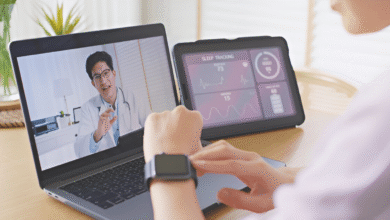How to Use Telehealth Effectively A Guide for U.S. Patients
Telehealth guide for U.S. patients Learn to use virtual care effectively for convenient secure and cost-effective healthcare access.

Telehealth Effectively has transformed the way Americans access healthcare, offering a convenient and efficient alternative to traditional in-person visits. With the rise of digital health platforms, patients can now consult doctors, manage chronic conditions, and receive mental health support from the comfort of their homes. However, to make the most of telehealth, it’s essential to understand how it works, when to use it, and how to prepare for virtual appointments. This guide provides practical tips to help U.S. patients navigate telehealth effectively, ensuring seamless communication with healthcare providers and optimal care outcomes.
The adoption of Telehealth Effectively surged during the COVID-19 pandemic, but its benefits such as reduced travel time, lower costs, and increased accessibility have made it a permanent fixture in modern healthcare. Whether you’re scheduling a routine check-up, discussing test results, or seeking specialist advice, Telehealth Effectively can save time while maintaining high-quality care. Yet, not all medical concerns are suitable for virtual visits, and technical or logistical challenges can arise. By learning best practices for telehealth, patients can enhance their experience, avoid common pitfalls, and take full advantage of this innovative healthcare solution.
How to Use Telehealth Effectively A Guide for U.S. Patients
Convenience and Accessibility
Telehealth eliminates geographical barriers, allowing patients in rural or underserved areas to access specialists without long commutes. Busy professionals, parents, and individuals with mobility challenges can attend appointments from home or work, saving time and reducing stress. Virtual care also minimizes exposure to contagious illnesses a crucial benefit for immunocompromised patients or during flu season.
Cost-Effectiveness and Efficiency
Virtual visits typically have lower copays than in-person appointments and eliminate transportation/parking costs. For chronic conditions like diabetes or hypertension, Telehealth Effectively enables regular check-ins and remote monitoring, preventing costly emergency room visits or hospitalizations. Insurers increasingly cover telehealth, making it an affordable option for routine care, mental health counseling, and prescription management.
Limitations and Appropriate Use
While Telehealth Effectively excels for follow-ups, mental health, and minor illnesses, it has boundaries. Physical exams, imaging, and emergencies (e.g., chest pain, severe injuries) require in-person care. Technical issues (poor internet, device limitations) can also hinder access. Patients should consult providers to determine when telehealth is suitable versus when a clinic visit is necessary for accurate diagnosis and treatment. These points highlight telehealth’s transformative potential while acknowledging scenarios where traditional care remains essential.
Choosing the Right Telehealth Platform
Platform Compatibility & User Experience
Choose a Telehealth Effectively service that works seamlessly with your devices (smartphone, tablet, or computer) and doesn’t require cumbersome downloads. Web-based platforms that operate through browsers (like Chrome or Safari) often provide easier access than app-only systems. Prioritize intuitive interfaces with clear instructions for scheduling, joining appointments, and accessing medical records to minimize technical frustrations.
Security & HIPAA Compliance
Ensure the platform uses end-to-end encryption and complies with HIPAA regulations to protect your private health data. Look for certifications or privacy policies that confirm adherence to healthcare security standards. Avoid platforms with a history of data breaches or poor reviews regarding confidentiality. Features like secure messaging and encrypted video calls are essential for safe provider-patient communication.
Insurance Coverage & Added Features
Verify whether your insurance plan partners with specific Telehealth Effectively providers (e.g., Teladoc, Amwell) to avoid out-of-network fees. Some insurers offer reduced copays for preferred platforms. Additionally, consider extra features like e-prescriptions, lab test coordination, or AI symptom checkers, which can streamline care. Confirm whether the platform integrates with your existing Electronic Health Record (EHR) for seamless medical history access. These points help ensure you select a secure, convenient, and cost-effective telehealth solution tailored to your needs.
Preparing for a Telehealth Appointment
To make the most of your Telehealth Effectively visit, preparation is key. Start by testing your technology beforehand. Ensure your internet connection is stable, your camera and microphone work, and you have the necessary software installed. A poor connection can disrupt the consultation and waste valuable time. Gather relevant medical information, including A list of current medications. Recent lab results or imaging reports. Symptoms and their duration. Questions for your provider. Having these details ready helps your doctor make informed decisions. Choose a quiet, well-lit space for the appointment to ensure clear communication. Background noise or poor lighting can interfere with the consultation.
Maximizing Your Telehealth Visit
During the appointment, communicate clearly and concisely. Describe your symptoms in detail, including when they started and what makes them better or worse. Since the provider can’t perform a hands-on exam, your input is crucial for an accurate assessment. Take notes during the visit to remember follow-up instructions, medication changes, or referrals. If something is unclear, don’t hesitate to ask for clarification. Many patients feel rushed during virtual visits, so advocating for yourself ensures you get the care you need. After the appointment, follow through with any recommended next steps, such as scheduling lab tests or follow-ups.
Overcoming Common Telehealth Challenges
Despite its benefits, Telehealth Effectively has limitations. Technical difficulties, such as frozen screens or audio delays, can disrupt appointments. Having a backup plan (like switching to a phone call) helps mitigate these issues. Some patients struggle with the lack of physical interaction, making it harder to build rapport with providers. Choosing a consistent telehealth provider for ongoing care can help establish trust. Additionally, not all conditions can be diagnosed virtually, so knowing when to seek in-person care is essential. Always verify coverage and potential out-of-pocket costs before scheduling an appointment.
The Future of Telehealth
Telehealth Effectively is continuously evolving, with advancements like AI-driven diagnostics, wearable health monitors, and virtual reality therapy on the horizon. Policymakers are also working to expand telehealth access, particularly for underserved populations. As technology improves, telehealth will likely become a standard part of healthcare. Patients who adapt now will be better positioned to benefit from future innovations. Staying informed about new platforms, regulations, and best practices ensures you can use telehealth effectively for years to come.
Read More: How Red Light Therapy Devices Are Being Used at Home
Conclusion
Telehealth has emerged as a powerful tool in modern healthcare, offering U.S. patients greater flexibility, accessibility, and convenience in managing their health. By understanding how to navigate virtual appointments, choose the right platforms, and communicate effectively with providers, patients can maximize the benefits of telehealth while avoiding common challenges. Whether for routine consultations, chronic disease management, or mental health support, telehealth provides a practical solution that complements traditional in-person care, particularly for those with limited mobility or in rural areas.
As technology continues to evolve, telehealth will likely play an even greater role in healthcare delivery, with advancements like AI-assisted diagnostics and remote monitoring enhancing its capabilities. To make the most of this innovation, patients should stay informed about best practices, ensure they have the necessary technology, and advocate for their needs during virtual visits. By embracing telehealth as a key part of their healthcare routine, patients can enjoy more efficient, cost-effective, and personalized medical care ultimately leading to better health outcomes and a more patient-centered experience.
FAQs
Is telehealth covered by insurance?
Many U.S. insurers cover telehealth, but policies vary. Check with your provider to confirm eligibility and potential copays.
What conditions can be treated via telehealth?
Telehealth is suitable for colds, allergies, mental health counseling, chronic disease management, and follow-up visits.
Do I need special equipment for a telehealth visit?
A smartphone, tablet, or computer with a camera, microphone, and stable internet connection is typically sufficient.
How do I ensure my telehealth visit is private?
Use a secure, HIPAA-compliant platform and conduct the appointment in a quiet, private space.
Can prescriptions be refilled through telehealth?
Yes, providers can electronically send prescriptions to your pharmacy if deemed medically appropriate.











